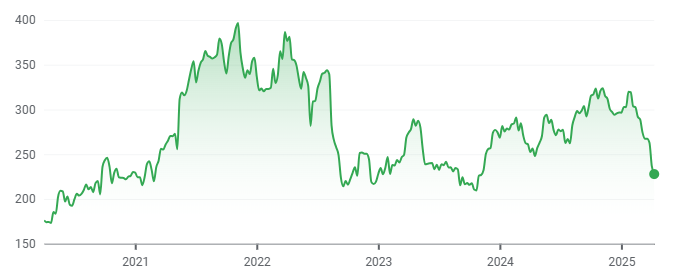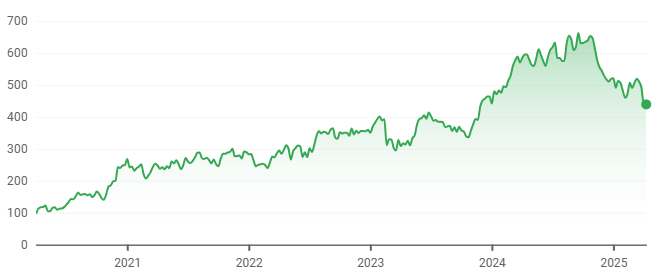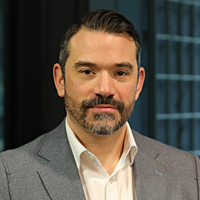Want to find the next Nvidia? Here are two companies shaking things up
In 1993, a little-known chip design company was founded in a Denny's Restaurant in Santa Clara, California. At the time, there was nothing particularly remarkable about it—no bold predictions, no flood of investor capital, no headlines.
The company listed on the Nasdaq in 1999. Once again, it drew little attention. It was one of many small players trying to survive in the shadow of semiconductor giants.
Today, that company is worth over $2.3 trillion. It has generated staggering wealth for its founders and early backers. And it now sits at the heart of the world’s most advanced computing systems.
It wasn’t until around 2016 that the company truly started to turn heads, as the potential of its GPU technology began to be appreciated well beyond gaming. By 2020, it was considered indispensable to fields like artificial intelligence, machine learning, and high-performance computing.
Yes, the company I’m referring to is Nvidia (NASDAQ: NVDA). For over a decade, it was just another name in tech — not ignored, but far from celebrated. Then, almost overnight, it became the most important chipmaker on the planet.
The Nvidia story is now well known, and not every company will grow into a multi-trillion-dollar behemoth. But it's also true that if you don't look for these opportunities, you won't find them.
So, which companies are quietly building something transformational, far from the spotlight — for now? That's the question, along with a few others, that I put to Michael Poulsen, co-founder of Canopy Investors, and Simon Wood, Portfolio Manager for the Ausbil Global Small Cap Fund.
SONOVA HOLDING (SWX: SOON) - Michael Poulsen - Canopy Investors

What is the company, and what is it doing?
Listen up! Swiss company Sonova is the leading manufacturer of hearing aids globally, sold under the Phonak and Unitron brands, with approximately 30% market share. It is also among the largest retailers of hearing aids worldwide through the AudioNova network of clinics, owns the Sennheiser consumer audio business, and has a small cochlear implant division which competes with ASX-listed Cochlear. Around 50% of its revenue comes from Europe, the Middle East, and Africa, around 30% from the USA, and Asia Pacific makes up most of the remainder.
How could it change people's lives?
According to the World Health Organization, hearing loss affects 430 million people worldwide, and this is projected to reach 700 million by 2050, in part due to an ageing population. Untreated hearing loss is linked to serious health issues beyond hearing difficulty, including dementia, cognitive decline, falls, and social isolation. Despite this, penetration of hearing aids remains relatively low, particularly in emerging markets, highlighting a substantial unmet need.
Over the past 30 years, the hearing aid industry has seen major technological advancements that have greatly improved outcomes for people with hearing loss.
Sonova has been at the forefront of these innovations, pioneering developments such as the first directional microphone technology, Bluetooth connectivity, rechargeable devices, miniaturization, and more recently, reductions in background noise using a proprietary AI chip.
Why do you like it?
The hearing aid market is concentrated, with the top five global players holding 95% market share. Barriers to entry are high, with Sonova having spent decades investing in differentiated intellectual property, benefiting from established brands and a strong distribution network, including its AudioNova and third-party clinics. While users typically replace their hearing aids every five years, they often stay with the same brand due to familiarity with the device and its accompanying app. Brands also have different methods of modulating sound, which users’ brains adapt to over time, leading to frustration when trying another provider’s hearing aids. These advantages should allow Sonova to maintain or grow its market share.
Sonova recently launched a new platform called Infinio, which uses an integrated, proprietary chip and AI to process sound in real time, separating clear speech from background noise.
We believe this new platform demonstrates genuine innovation and technological differentiation, is first to market, and has experienced strong customer demand.
What needs to happen for it to reach the next level?
A significant opportunity lies in addressing the vast population of people with mild to moderate hearing loss who do not use hearing aids, as well as in accelerating their path to seeking help.
Should Sonova continue to innovate and improve the utility, comfort, and style of its hearing aids, including via its Infinio platform, it should grow market share and drive greater penetration among the hundreds of millions in need.
What are the key risks to the thesis?
In 2021, the FDA in the USA permitted some hearing aids to be sold over the counter and without a prescription, increasing the risk of competition and pricing pressure at the lower end of the market. Recently, Apple introduced new hearing features with its AirPods Pro 2, raising concerns that it could reduce demand for Sonova’s products. While acknowledging these risks, hearing loss is a complex problem that we believe is best addressed with hearing aids specifically designed to solve it. Users typically prefer low-profile devices that can be worn all day, along with a professional fit and regular adjustments. It is possible that new low-end hearing devices actually increase awareness of the impact of hearing loss, expanding Sonova’s addressable market. In the longer term, there is a risk that medical or technological advancements result in a completely different approach to solving hearing loss, which we’d consider to be a lower-probability tail risk.
All in all, we consider Sonova to be a very ‘sound’ investment opportunity.
NKT (CPH: NKT) - Simon Wood - Ausbil
What is the company, and what is it doing?

The world is electrifying at an unprecedented pace. As economies transition away from fossil fuels, the demand for reliable, high-capacity power infrastructure has never been greater. The rise of electric vehicles (EVs), artificial intelligence (AI), data centres, and U.S. manufacturing onshoring is further accelerating electricity consumption, making efficient power transmission more crucial than ever. Renewable energy sources like wind and solar are expanding rapidly, but they require advanced transmission solutions to ensure that clean electricity reaches the people and industries that need it.
One company at the forefront of this transformation is NKT, a Danish firm specialising in high-voltage power cables.
Founded in 1891, NKT has evolved into a leading provider of advanced cable solutions that support the global transition to clean energy. The company is particularly strong in the high-voltage and extra-high-voltage cable market, which is critical for offshore wind farms, interconnectors between countries, and modernising aging electrical grids. With manufacturing facilities in Denmark, Sweden, Germany, Poland, and the Czech Republic, NKT plays a vital role in ensuring the world's energy infrastructure can support the ongoing electrification of our daily lives.
How could it change people's lives?
NKT’s high-voltage cables are essential for the clean energy revolution. As the world moves toward renewable sources like offshore wind and solar power, efficient energy transmission is crucial.
NKT’s technology enables electricity generated in remote locations—such as offshore wind farms—to be transported efficiently to population centres, reducing reliance on fossil fuels.
The company’s cables are also used in interconnectors that link national grids, improving energy security by allowing countries to share electricity and balance supply and demand. This has a direct impact on people’s lives by promoting stable electricity prices, reducing carbon emissions, powering our EVs and AI technology, and enabling the large-scale adoption of renewable energy.
Why do you like it?
NKT is not just another cable manufacturer—it is pioneering the future of electricity transmission.
Its innovations in HVDC (High Voltage Direct Current) technology allow for more efficient and lower-loss power transmission over vast distances, making it possible to integrate offshore wind farms and interconnect national grids at an unprecedented scale. The company is also pushing the boundaries of subsea cable technology, designing systems that can withstand extreme environmental conditions and provide ultra-reliable performance over decades. Additionally, NKT is investing in next-generation materials and digital monitoring solutions, enabling real-time performance tracking and predictive maintenance, which reduces downtime and enhances grid stability. In our view, this technological edge gives NKT a competitive advantage in an industry where reliability and efficiency are paramount.
We believe that NKT stands out as the niche leader within its industry with a high-quality management team benefiting from strong macroeconomic tailwinds.
The demand for high-voltage cables is surging due to global investments in offshore wind power, cross-border electricity interconnectors, the adoption of EVs and AI technology, and grid modernisation. Governments and corporations worldwide are committing to net-zero emissions targets, and NKT is well-positioned to capitalise on this trend. Unlike many companies in the renewable energy space that struggle with profitability, NKT has strong financials, a robust order backlog, and industry-leading expertise. The company’s recent expansion into next-generation HVDC cables positions it for even greater growth as this technology becomes the standard for long-distance power transmission.
What needs to happen for it to reach the next level?
For NKT to scale up further, it needs to continue expanding its manufacturing capacity and technology leadership.
The demand for high-voltage cables is outpacing supply, meaning companies with greater production capabilities will be best positioned to capture market share.
NKT is investing in new factories and higher-capacity production lines, which will be crucial to meeting future demand. Additionally, securing large, long-term contracts with governments and utilities, we believe, will provide revenue stability. Another key factor is technological leadership, by staying ahead in HVDC innovation, NKT can continue to be a preferred supplier for the world’s most ambitious energy projects.
What are the key risks to the thesis?
Despite its strong position, NKT faces several risks. First, competition in the high-voltage cable market is fierce, with players like Prysmian and Nexans also vying for contracts. If competitors can scale faster or offer superior technology, NKT could lose market share. Second, raw material costs (especially copper and aluminium) are a major factor in cable production; price volatility could pressure margins. Third, project delays due to regulatory approvals, permitting issues, or supply chain disruptions could impact revenue timing. Finally, the company’s growth is tied to government energy policies; changes in subsidies or political will for renewable energy projects could slow demand.
We believe that NKT is a hidden gem in the global small-cap space, playing a crucial role in the global energy transition. With its expertise in high-voltage cables, the company is enabling the large-scale adoption of renewable energy, cross-border electricity trade, and grid modernisation. While risks exist, its strong market positioning, growing demand, and technological advancements makes it a compelling investment opportunity.
If NKT continues executing on its strategy, it has the potential to become a much larger player in the global energy infrastructure landscape.
1 topic
1 stock mentioned

